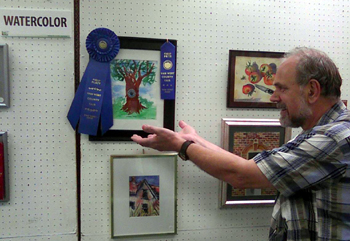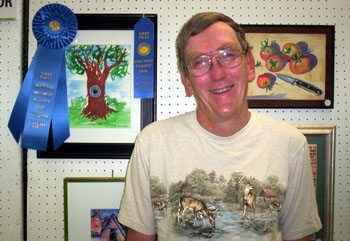Fair art exhibit spotlights local artists
By Hope Wallace

Thanks to all of the artists and photographers who contributed to the exhibit at the Van Wert County Fair! The art exhibit was judged by, Jens Svendsen of Hamler. Jens has taught art at Bowling Green State University, has a Masters of Art in Fine Art and an R.N. in psychiatric nursing. Originally hailing from Denmark, Jens has a broad appreciation for visual art.
In his juror’s statement, Jens says, “I would like to take some time to thank the Van Wert County Foundation for inviting me as juror for this fine arts show, and to share my reflections about the works presented. An annual County Fair is all about people and the community they belong to — a place where pride merges with fun and all the best such a community has to offer. This is also the case for a County Fair Fine Arts Show where one can come across the unexpected and the originally vibrant. As juror of the Van Wert County Fair I was delighted to experience work of such diverse nature. The work awarded had that extra nerve and appeal that makes for a work out of the ordinary.”
He went on to say that art exhibits can be challenging to jury because of their subjective nature and it should be of little consequence whether or not an award was given, “because the overall presence of affirmation of life and joy was immediate and moving. My own contribution to this show is to encourage everyone to ‘keep at it’ and continue to be the life force at these events.”
I couldn’t agree more. Van Wert was fortunate to have Jens’ input and we can look forward to an exhibit of work by him and his wife, Mille Guldbeck in 2012. Like Jens, Mille teaches at Bowling Green and is represented many galleries throughout the world.

Best of Show went to Val Sluterbeck of Van Wert for his watercolor painting, “Eyeball Tree.” Second best of show went to Kylene Murphy of Mendon, with Third Best of Show winner being Danielle Bradford of Van Wert. Others who placed were: Oil or Acrylic: first place — Janet Ravas of Scotia, New York; second place –Val Sluterbeck; third place – Kay Sluterbeck of Van Wert. Watercolor: first place – Val Sluterbeck; second place – Kay Sluterbeck; – third place – Janet Ravas. Drawing: first place – Danielle Bradford; second place – Jackie Brandt; third place – Kylene Murphy. Pastel: first place – Deborah Steinmetz; second place – Deborah Steinmetz; third place – Kylene Murphy. Mixed Media: first place – Pat Rayman of Ohio City; second place – Pat Rayman; third place – Kay Sluterbeck. Ink: first place – Kylene Murphy; second place – Kylene Murphy; third place – John Lianez. New this year was the “Director’s Choice Award”. In painting it went to John Lianez and for photography, Josh Hattery.
Tuesday night our art classes began with “Drawing in Your Right Mind.” I’m writing this Tuesday morning and I can’t wait. Please check out our schedule or give us a call to find out to find out what class interests you! The line-up of classes includes: “Drawing in your Right Mind,” “Landscape Oil Painting with Sally Geething, “Watercolor and Mixed Media,” “Dynamic Acrylic Painting,” “Anime/Manga”, “Beginning Drawing,” “Claymation,” “Medieval Multimedia” and “Initial Line Art.” Instructor Matt Temple has been working with the art center’s printmaking equipment and bringing it back to life, so stay tuned for more offerings soon!
Contact the art center at 419.238.6837 or wassenberg@embarqmail.com for further information or to register. Class size is limited, and preregistration is required. The Wassenberg Art Center is located at 643 S. Washington Street in Van Wert, Ohio.
Annie wins shootout and gentleman’s heart
By Kay Sluterbeck
(Continued from last week: To save money, 10-year-old Annie Moses was sent by her mother to live with a farmer and his wife who promised her a good life with plenty of time to hunt and fish. However, they beat her and treated her like a slave.)
After two years of abuse, Annie ran away. She went to the Edingtons, at the Darke County Infirmary where she had previously worked, for help. After the Edingtons saw the welts and scars on her back from the beatings, they told the 12-year-old to stay with them. When the farmer came looking for her, they refused to let him take Annie back.
When she was 14 or 15, Annie returned to live with her family. Her mother had married again, and the family bought land near North Star, Ohio. The mortgage was high, so Annie began hunting in earnest. Whatever game the family couldn’t eat, she sold to the grocer in Greenville, who then sold it to hotels in Cincinnati. Each mail day she sent hampers of quail done up in bunches of sixes or twelves. “I was not …a game hog,” she recalled. “There was plenty, and I just had to help pay for the new home.”
When Annie went to visit her married sister in Cincinnati, she met the owner of a hotel that had bought some of her game. He asked if she would be interested in having a shooting match with an expert marksman who was then appearing in the city. The prize was $50. Annie accepted with great hopes of winning.
Annie was still so young that she was not yet wearing long dresses. The marksman, Frank Butler, an adventurous man in his mid-20s, had no idea who he would be competing against. “I almost dropped dead when a little slim girl in short dresses stepped out to the mark with me,” he said later. Each shooter was to try to shoot 25 live pigeons as they flew out of traps one at a time. Each contestant shot perfectly until Frank missed his 25th bird — and Annie shot hers. She won the match and Frank’s heart at the same time. They married in 1876.
At first Frank continued to travel with the Sells Brothers Circus, performing shooting exhibitions with his partner, and Annie stayed behind to help her family. In 1882 the team was to appear in Springfield, Ohio, but Frank’s partner got sick and Frank asked Annie to help him by holding the objects as he shot. “Or so he thought,” she said, “But I rebelled.”
That evening Annie insisted on taking every other shot. The crowd went wild every time she hit the mark. Frank, no fool, knew a star when he saw one. “She outclassed me,” he wrote later. Frank made Annie his new shooting partner, taught her many of his trick shots, and gradually made her the focus of the act. She chose “Annie Oakley” as her stage name. No one is sure where the name “Oakley” came from; it is thought it may have been the name of a man who helped her when she ran away from the farmer who had abused her.
The team of Butler and Oakley performed in theaters and skating rinks all around the Midwest. Frank managed the act, and Annie designed and sewed her own costumes. In March 1884 after a show in St. Paul, Minnesota, the Sioux chief Sitting Bull, who was in the audience, asked to meet her. Annie was tired, so she politely refused.
But Sitting Bull, whose army had defeated Custer’s troops at the Battle of Little Bighorn, was persistent. He kept sending messages to Annie. Finally she went to visit him. It turned out that the little markswoman with long, dark hair strongly reminded the chief of his beloved daughter, who had died some years earlier. He gave Annie the moccasins (made by his daughter) that he had worn in the 1876 battle. And, although official papers were never filed, Sitting Bull adopted Annie, giving her an Indian name, “Watanya Cecila,” or “Little Sure Shot.”
(To be continued)
POSTED: 09/07/11 at 9:15 am. FILED UNDER: What's Up at Wassenberg?







